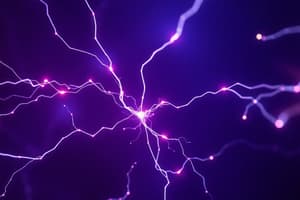Podcast
Questions and Answers
What is the fundamental property of matter that can be positive or negative?
What is the fundamental property of matter that can be positive or negative?
Electric charge
What is the formula for Coulomb's Law?
What is the formula for Coulomb's Law?
F = k * (q1 * q2) / r^2
What is the direction of the electrostatic force between two point charges?
What is the direction of the electrostatic force between two point charges?
Attractive for opposite charges and repulsive for like charges
What is the unit of electric field?
What is the unit of electric field?
How is electric field calculated?
How is electric field calculated?
What is the direction of electric field lines?
What is the direction of electric field lines?
What is the unit of electric potential?
What is the unit of electric potential?
What is electric potential difference?
What is electric potential difference?
What is the relationship between electric field and electric potential?
What is the relationship between electric field and electric potential?
What is an equipotential surface?
What is an equipotential surface?
Flashcards are hidden until you start studying
Study Notes
Electrostatics
- Electric Charge: A fundamental property of matter that can be positive or negative.
- Coulomb's Law: Describes the electrostatic force between two point charges:
- Force: F = k * (q1 * q2) / r^2, where k is Coulomb's constant, q1 and q2 are the charges, and r is the distance between them.
- Direction: Force is along the line joining the charges, attractive for opposite charges and repulsive for like charges.
Electric Field
- Definition: A vector field that surrounds charged particles, describing the electrostatic force per unit charge at a given point.
- Units: N/C (Newtons per Coulomb)
- Calculation: E = F / q, where F is the electrostatic force and q is the test charge.
- Electric Field Lines:
- Start at positive charges and end at negative charges.
- Never intersect or touch each other.
- Are continuous and unbroken.
Electric Potential
- Definition: The potential energy per unit charge at a given point in an electric field.
- Units: J/C (Joules per Coulomb), also known as Volts (V).
- Calculation: V = U / q, where U is the potential energy and q is the test charge.
- Electric Potential Difference (Voltage):
- The difference in electric potential between two points.
- Measured in Volts (V).
Key Concepts
- Equipotential Surfaces: Surfaces where the electric potential is the same at every point.
- Electric Potential Gradient: The rate of change of electric potential with distance.
- Electric Field and Potential Relationship: E = -∇V, where E is the electric field and V is the electric potential.
Electrostatics
- Fundamental Property of Matter: Electric charge can be positive or negative.
- Coulomb's Law: Describes the electrostatic force between two point charges, with the force being proportional to the product of the charges and inversely proportional to the square of the distance between them.
Electric Field
- Definition: A vector field that surrounds charged particles, describing the electrostatic force per unit charge at a given point.
- Units: Measured in Newtons per Coulomb (N/C).
- Calculation: Electric field (E) is calculated by dividing the electrostatic force (F) by the test charge (q).
- Electric Field Lines:
- Originate from positive charges and terminate at negative charges.
- Never intersect or touch each other.
- Are continuous and unbroken.
Electric Potential
- Definition: The potential energy per unit charge at a given point in an electric field.
- Units: Measured in Joules per Coulomb (J/C), also known as Volts (V).
- Calculation: Electric potential (V) is calculated by dividing the potential energy (U) by the test charge (q).
- Electric Potential Difference (Voltage):
- The difference in electric potential between two points.
- Measured in Volts (V).
Key Concepts
- Equipotential Surfaces: Surfaces where the electric potential is the same at every point.
- Electric Potential Gradient: The rate of change of electric potential with distance.
- Electric Field and Potential Relationship: The electric field (E) is equal to the negative gradient of the electric potential (V).
Studying That Suits You
Use AI to generate personalized quizzes and flashcards to suit your learning preferences.




